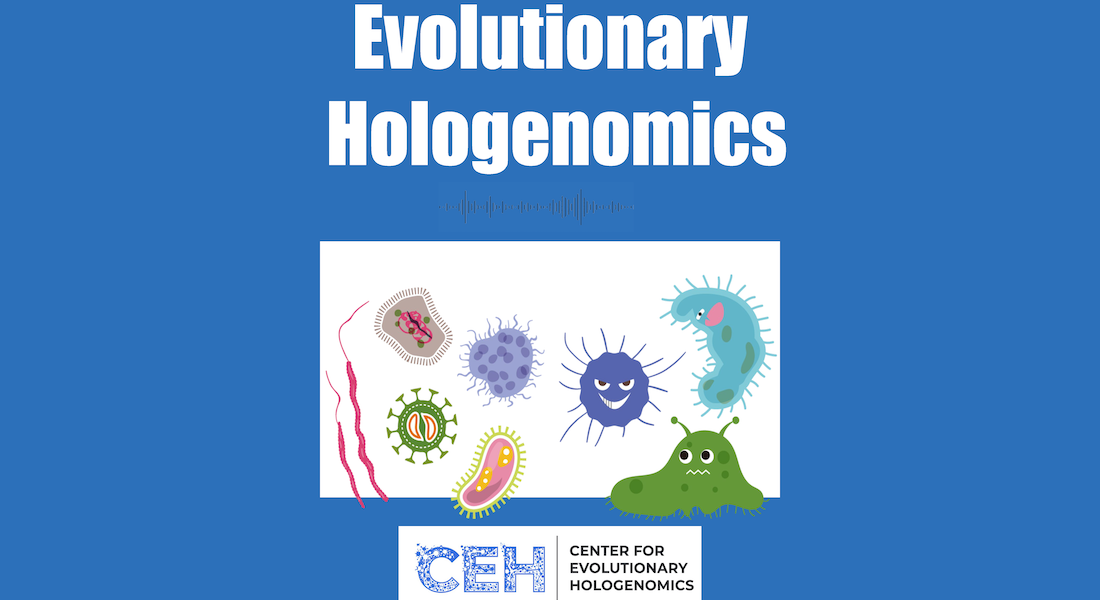Evolutionary Hologenomics Podcast Anniversary
The Evolutionary Hologenomics Podcast celebrates one year anniversary with an interview with Center Director Tom Gilbert. In this episode Tom reflects on how the Center for Evolutionary Hologenomics came to be, how it's doing and what's next.

Fascination of microbes
The podcast was started by Project and Outreach Manager Ana Veríssimo at the Center for Evolutionary Hologenomics (CEH) in June 2021. In the podcast Ana and researchers from around the world talk hardcore science in simple terms and Ana mentions that a side effect of listening to the podcast might be that you become fascinated by and obsessed with microorganisms and their interactions. We asked Ana a few questions to learn more about her thoughts behind the podcast.
What made you start the podcast series?
“I am a big fan of podcasts that can be listened to on the go. Some are educational, some are entertaining, some are weird, and some challenge our beliefs and way of thinking. Working at CEH, being interested in science communication, and having first-hand access to all the amazing research that is done at the centre, I thought it would be a great idea to start a podcast to share it with the world. The tone is informal and we provide our listeners with an insight into not only some of our results and what they mean for the bigger picture, but also what it is that scientists actually do as a job. Being a scientist is a very broad job and what they actually do varies a lot, from writing grants and papers, attending conferences, to field work, lab work, computer work, and often a mixture. So, hopefully the podcast will showcase our research in evolutionary hologenomics, highlight the people working at our centre, teach someone something new and, who knows, have people contacting us to collaborate and do research together!" says Ana.
What do you hope the listeners take away from an episode?
"People consume information in different ways, so the podcast has an audio version, as well as a Youtube version, for our more visual audience. People watching on Youtube get to see some images, but we always describe what we are looking at so that whoever is listening on the go is not missing out. Our audience is a mix of scientists and non-scientists so instead of avoiding jargon, we go ahead and use it and explain in simple terms what the complicated words mean. This way, everyone feel included and learn something new. Although all podcast episodes are about evolutionary hologenomics in some form, there are so many different angles, species, applications, experiments and analyses that can be done, so hopefully each episode adds a little extra piece to a very big puzzle that keeps growing.” Ana says.
Anniversary episode with Centre Director and Professor Tom Gilbert
In this special anniversary episode Centre Director Tom Gilbert reflects on how he and his team managed to get a centre of excellence funded by the Danish National Research Foundation, how they were turned down the first time and how finally getting the Center for Evolutionary Hologenomics has opened up for so many new possibilities and collaborations.
Who will be featured in the next episode?
“So far, the podcast consists of six episodes where all the guests have been from CEH and the discussions have been focussed on the microbiome and hosts. That is great, and we will continue to do more in the future. However, it is clear that microbial communities are complex and small changes can have a big impact so, to accurately describe and understand the interactions and balance, we need knowledge from different fields. For that purpose, I will try to have some guests who don’t necessarily work on hologenomics but have transferable knowledge that can be applied to the field. Something else that could be fun, since I will be attending the exciting Applied Hologenomics Conference in Bilbao in September, would be to try and catch up with some speakers and participants and do a little mixtape from the conference.” Ana ends.
